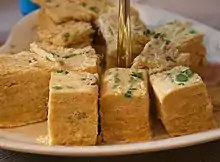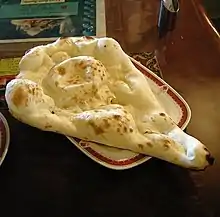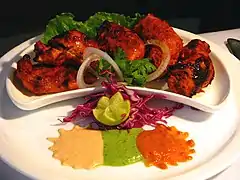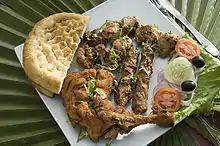Soan papdi
Sohan papdi (also known as san papri, shompapri, sohan papdi, shonpapdi or patisa)[1] is a popular dessert in the Indian subcontinent. Soan Papdi has no confirmed origin, but it is believed to have originated in the western state Maharashtra, India.[2] According to a culinary anthropologists, the word "soan" has Persian origin and the name comes from the term sohan pashmaki.[3] Others speculation also includes that ranges from Rajasthan, Uttar Pradesh, Punjab and West Bengal.[4][5] It bears some resemblance to the Dragon's beard candy in China, Kkul-tarae in Korea,[6] Persian pashmaki, which gave rise to the Turkish pişmaniye.[7] It is usually cube-shaped or served as flakes, and has a crisp and flaky texture. Traditionally sold loose in rolled paper cones, modern industrial production has led it to being sold in the form of tightly formed cubes.[1]

See also
- Sohan (confectionery)
- Sohan halwa
- Pişmaniye, a similar Turkish dessert
- Pashmak, a similar Iranian dessert
References
- "Soan Papdi". Food-india.com. Retrieved September 17, 2012.
- https://www.indiatimes.com/explainers/trending/explained-how-was-soan-papdi-invented-582782.html
- "Diwali is incomplete without soan papdi; what makes this humble dish so popular in India?". Indian Express. Retrieved 2023-09-09.
Kurush F Dalal, archaeologist and culinary anthropologist, calls it an "incredibly versatile" dish. "Soan papdi is a Persian dish. It comes from [the word] 'sohan pashmaki'.
- https://web.archive.org/web/20131023062240/http://www.ifood.tv/network/patisa
- https://www.awesomecuisine.com/recipes/312/soan-papdi/
- "Cotton Candy". stonesoup.com. Retrieved 2023-04-12.
- "20 Indian Desserts You Need to Try - Nomad Paradise". Nomad Paradise. 2022-01-30. Retrieved 2022-04-11.
Believed to have been derived from the Turkish Pismaniye, soan papdi is often referred to as Indian candy floss as it has a strand-like texture that makes it so soft and flaky.
- "Diwali". Indiaoz.com.au. Retrieved September 17, 2012.
External links
- Annotated video recipe illustrates traditional hand-made technique for creating Soan Papdi's crisp multi-layers (filmed at Shreya's Sweets Hampankatta, Mangalore); ·Permaculturetravel· YouTube Channel
- Demonstration of modern mechanized equipment in the making of pişmaniye, a related Turkish confection



